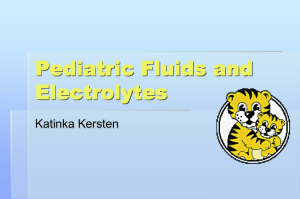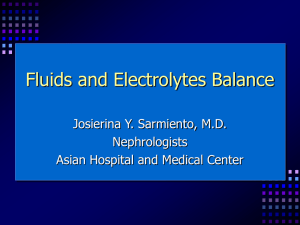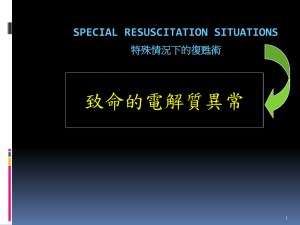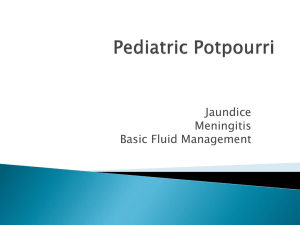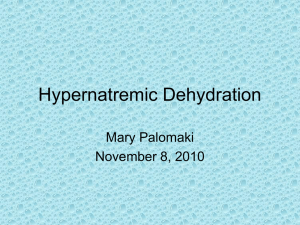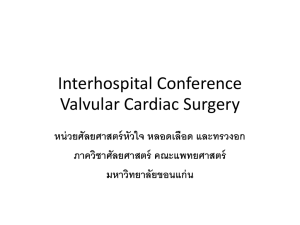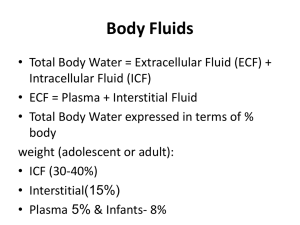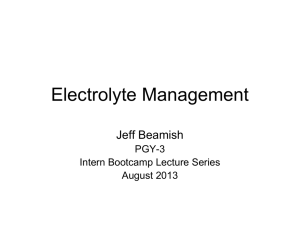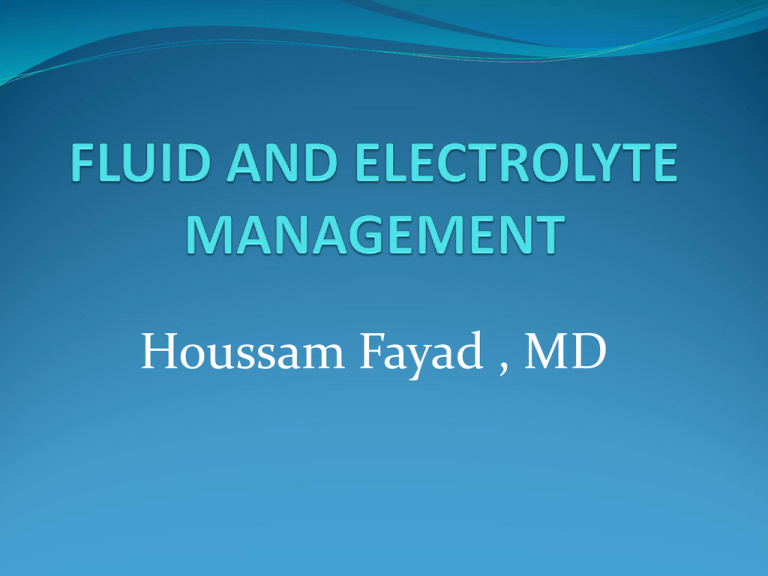
Houssam Fayad , MD
COMPOSITION OF BODY FLUIDS
Water is the most plentiful component of human body
Total body water (TBW):
constitutes 50-75% of total body mass, depending on
age, sex and fat content.
TBW
-TBW decreases to
75% in a full term
neonate
80
Body weight (%)
-Fetus has a very high
water content
70
60
50
Intracellular fluid
40
-During 1 year of life
TBW content decreases
to 60% and remains
same until puberty.
Extracellular fluid
Total body water
30
20
10
0
0
1
10
20
Age (years)
FLUID
COMPARTMENTS
ICF 40%
1. In newborn
ECF>ICF
1. By 1 year of age
ratio of ICF to
ECF approaches
the adult level.
INTERSTITIAL
15%
ECF 20%
PLASMA 5%
ELECTROLYTE COMPOSITION
ECF
ICF
CI Na +
Phos K+
HCO3 Prot -
K+
Prot Ca +
Mg +
Other
Phos -
Na +
HCO3 Mg +
CI -
OSMOLALITY
• ICF and ECF are in osmotic equilibrium
• Change in osmolality in one of the compartments
leads to water shift through the cell membranes to
normalize equilibrium
• Plasma osmolality:
• 285-295 mosm/kg
• Calculated based on formula:
• 2xNa+glucose/18+BUN/2.8
REGULATION OF OSMOLALITY
MAINTENANCE AND
REPLACEMENT THERAPY
• Therapy of fluid and electrolyte disorders directed
toward:
• Providing maintenance fluids and electrolyte
requirements
• Replenishing prior losses
• Replace persistent abnormal losses
MAINTENANCE AND
REPLACEMENT THERAPY
• Maintenance fluid requirement take into account:
• Normal insensible water losses
•
skin and lungs:
• 35%
• Urine:
•
60%
• Stool
•
5%
• Assuming that patient is afebrile and relatively inactive
MAINTENANCE AND
REPLACEMENT THERAPY
• Maintenance fluids are used when a child cannot be
fed orally.
• Replacement therapy needed when patient has
excessive ongoing losses from NG tube, ongoing
diarrhea or vomiting or high urine output due to
nephrogenic diabetes insipidus.
• Deficit therapy corrects dehydration or prior losses
COMPOSITION OF MAINTENANCE
FLUIDS
Water
Glucose
Sodium
Potassium
GOALS OF MAINTENANCE FLUIDS
Prevent dehydration
Prevent electrolyte disorders
Prevent starvation ketoacidosis
Prevent protein degradation
MAINTENANCE WATER
1 ml of water needed for each calorie expended
Body
(kg)
Weight
3-10
Kcal/kg
mL of Water/kg
100
100
11-20
1000 kcal + 50
Kcal/kg for each
kg > 10 kg
1000 mL + 50 mL/
Kg for each kg >
10 kg
> 20
1500 kcal + 20
Kcal/kg for each
Kg > 20
1500 mL + 20
mL/kg for each
Kg > 20 kg
GLUCOSE IN MAINENANCE FLUIDS
How much glucose is required in maintenance fluids?
Why?
What % glucose solution will cover this requirement?
GLUCOSE IN MAINENANCE FLUIDS
• 20% of patient’s true caloric requirements needed to
prevent starvation ketosis and limit protein
catabolism.
• Example: 10 kg baby will need 1000 kcal/day
20% ----200 kcal/day from glucose
1 g glucose provides 4 kcal
X g glucose provides 200 kcal
X =50 g
50 g glucose in 1000 ml=> 5% glucose
MAINTENANCE ELECTROLYTES
SODIUM:
2-3 mEq/kg/24 hr or 3 meq/100cc
POTASSIUM:
1-2 mEq/kg/24 hr or 2 meq/100cc
COMPOSITION OF IV SOLUTIONS
FLUIDS
SODIUM CHLORIDE 0.9% NaCL
½ NS
1/3 NS
¼ NS
SODIUM CONCENTRATIONS
154 mEq
77 mEq
52 mEq
38 mEq
SELECTION OF SODIUM
CONCENTRATION IN IV
MAINTENANCE FLUIDS
Based on Na requirement/kg/day
10 kg baby needs 1000 cc of fluids and 30 meq/L Na=>
¼ NS
20 kg baby needs 1500 cc of fluids
Na requirements=3meq x 20 kg=60 meq
60 meq to be given in 1500 cc
X meq to be given in 1000 cc=> and 40 meq/L
Na=> ¼NS-1/3 NS
30 kg baby needs 1700 cc of fluids and 90 meq of Na to
be given in this volume of fluids=> 53 meq/L=>1/3 NS1/2 NS
CALCULATION OF KCL
REQUIREMENTS IN IV FLUIDS
• Calculate maintenance water requirements
• Calculate KCL requirement/kg/day
• Adjust KCL per liter of fluids
• EXAMPLE:
• 25 kg child needs 1600 cc of maintenance water
• 25kgx1-2mEq/kg/24 hr=25-50 mEq/24hr of KCL
• 1600 cc of water contains 25-50 mEq of KCL
1000 cc of water contains X mEq of KCL
X=15.63- 31.25 mEq=> 20 mEq
REMEMBER!
Maintenance fluids do not provide adequate calories.
Patient will lose 0.5-1% of weight each day.
TPN should be started for children who can not be fed
enterally for more than a few days
Certain conditions increase or decrease maintenance
requirements. Examples?
For each 1 degree increase in temperature above 38maintenance requirements are increased by 10%
REPLACEMENT FLUIDS
Diarrhea is often associated with loss of potassium and
bicarbonate leading to metabolic acidosis and
hypokalemia.
Concurrently, volume depletion leads to
hypoperfusion and lactic acidosis.
ADJUSTING FLUID THERAPY IN
DIARRHEA
Average composition of diarrhea:
Sodium: 55 meq/L
Potassium: 25 meq/L
Bicarbonate: 15 meq/L
APPROACH TO REPLACEMENT
THERAPY
GI losses can be measured
Replace losses as they occur every 2-6 hours depending
on the rate cc by cc
Use appropriate solution close in composition to
electrolytes being lost
Child should receive appropriate maintenance therapy
in addition to replacement therapy
Daily BMP
LOSS OF GASTRIC FLUID
Can occur via emesis or NG suction
What electrolytes are lost with gastric fluids?
• Sodium 60 meq/L
• Chloride 90 meq/L
• Potassium 10 meq/L
What metabolic disturbances it can cause?
hypokalemia and metabolic alkalosis
THIRD SPACE LOSSES
Occur after abdominal surgery
Results in shift of fluid from intravascular space into
interstitial space
Isotonic loss- best replaced by NS or RL
Cannot be quantitated
Replacement is based on continuing assessment of
intravascular volume status
DEHYDRATION-the most frequent
reason for hospitalization
INCREASE LOSSES
Vomiting:
AGE
Pyloric stenosis
Pyelonephritis
Increased ICP
Abdominal obstruction
Appendicitis
Pancreatitis, etc
Diarrhea:
AGE
Malabsorption
milk-protein allergy,
IBD
DKA, DI, burns
DECREASED INTAKE
Gingivostomatitis
Pharyngitis
Fever
Altered mental status
Physical restriction
Dependence on caregiver
CLINICAL SIGNS OF DEHYDRATION
Symptom/Sign
Moderate
Dehydration
Mild Dehydration
Severe Dehydration
Level of consciousness* Alert
Lethargic
Capillary refill*
2 Seconds
2-4 Seconds
Obtunded
Greater than 4 seconds,
cool limbs
Mucous membranes*
Normal
Dry
Parched, cracked
Tears*
Normal
Decreased
Absent
Heart rate
Slight increase
Increased
Very increased
Respiratory rate
Normal
Increased
Increased and hyperpnea
Blood pressure
Normal
Normal, but orthostasis
Decreased
Pulse
Normal
Thready
Faint or impalpable
Skin turgor
Normal
Slow
Tenting
Fontanel
Normal
Depressed
Sunken
Eyes
Normal
Sunken
Very sunken
Urine output
Decreased
Oliguria
Oliguria/anuria
DEHYDRATION SCORING SYSTEM
1.
2.
3.
4.
5.
6.
7.
8.
9.
10.
Decreased skin elasticity
Capillary refill>2 sec
Ill appeared(tired, somnolent, “washed out”)
Absent tears
Abnormal respirations
Dry mucous membranes
Sunken eyes
Abnormal radial pulse
Tachycardia
Decreased urine output (parental report)
DEHYDRATION SCORING SYSTEM
Score 0- no dehydration
Score 1-2- mild
Score 3-6-moderate
Score 7-10- severe
LABORATORY FINDING IN
DEHYDRATION-BMP
• Disproportionate increase of BUN with little or no
change of Creatinine
• due to increase passive reabsorption of urea in proximal
tubule due to appropriate conservation of Na and water
LABORATORY FINDINGS IN
DEHYDRATION
What changes in urinalysis may be present in
dehydration?
Elevation of spesific gravity
Proteinuria 30-100 mg/dL
Few WBC and RBC
Hyaline and granular casts
APPROACH TO DEHYDRATION
• Acute intervention to restore intravascular volume and
improve perfusion
• NS bolus 20 cc/hr over 20 min
• Deficit correction :
• Total amount of fluids includes maintenance and deficit
fluid
• Bolus is subtracted from the total volume
• Half of total fluids given over the first 8 hr, reminder
half-over the last 16 hr
ORAL DEHYDRATION THERAPY
Best used in the absence of shock
When poor perfusion is present
isotonic fluid bolus can restore perfusion, then oral
rehydration can proceed.
Glucose is actively absorbed and Na is co-transported
across gut mucosa
optimal glucose transport at concentrations:
glucose 2-2.5gm/L Na 45-90 mEq/L
higher glucose concentration will exacerbate diarrhea
and Na loss
ORAL REHYDRATION THERAPY
Aim is to replace fluid deficit over 4-6 hours
Calculate total volume to be given over 4 hours:
MILD=50 cc/kg
MODERATE=100 cc/kg
Calculate 5 min. aliquot volume:
Administer aliquot over 5 min period
Increase volume as tolerated
Maintenance: 100 mL of ORS/kg/24
ESTIMATED FLUID DEFICIT
Severity
Infants (weight <10 kg) Children (weight >10 kg)
Mild dehydration
5% or 50 mL/kg
3% or 30 mL/kg
Moderate dehydration
10% or 100 mL/kg
6% or 60 mL/kg
Severe dehydration
15% or 150 mL/kg
9% or 90 mL/kg
EXAMPLE
7 y.o. boy is admitted with 2-day hx of vomiting and
diarrhea. He is estimated to be 7% dehydrated and
vomited all attempts at oral dehydration in ER. He was
given 20 cc/kg of NS bolus prior to transfer to the
floor.
His weight is 23 kg
EXAMPLE
1.
2.
3.
4.
5.
6.
Maintenance water: 1560 cc=>65 cc/hr
Maintenance Na= 2-3 meq x 23 kg=46-69meq
Maintenance K=1-2 meq x 23=23-46 meq
Total fluid deficit=23kg x 0.07 x 1000cc/kg=1610 cc
Previous replacement=23 kg x 20cc/kg=460cc
Balance fluid deficit= 1610-460=1150cc=>1/2 is given
over the first 8 hr=72 cc/hr; another ½ over the last
16 hr=36 cc/hr
QUESTIONS
You are called to the ER to see a 4 month old baby boy
for admission as he has been having nasal congestion
and cough with decreases oral intake of one day
duration. Wet diapers decreased in the past 24 hours.
Vital signs as follow: HR of 160, RR of 50, O2 sat =95%,
temp = 100.7, weight = 17 Ibs. Normal physical
examination.
1) What percentage of dehydration is he?
2) How do you manage his fluids
3) Bolus
4) Maintenance fluids
QUESTIONS
You are the resident in the pediatric floor and your
fellow resident left you with an admission. The patient
is a 5 year old male with sickle cell whom is being
admitted as he has fever (Tmax 103F) x 2 days,
vomiting x 2 days (1 to 2 episoded per day), pain all
over and decreased po.
- Vital signs: pulse = 180, RR= 60, stable BP, O2 sat =
- 88% and. Weight = 44 Ibs.
- Physical examination shows crackles, dry mucous
membranes, cap refill 3 sec and he is in obvious
distress as he is crying in pain
QUESTIONS
You are assessing a 4 year old female for diarrhea x 7
-
-
days, fever x 4 days with Tmax of 101F, decreased po
intake and sleeping more than usual.
Vital signs: T=102F, Pulse = 130, RR= 20, O2 sat
=100%and BP = 60/50. Weight =35 Ib
Physical examination pertinent for a girl that is
lethargic but arousable to speech and touch, cap refil
is 4 sec
1) What is the percentage of dehydration ?
2) What type of fluid are you going to use
3) What is your management for her fluids
QUESTIONS
A one week old infant present to the ER with vomiting
x 3 days, diarrhea x 3 days, not feeding well, decreased
wet diapers x 2 days with no urine x 24 hours.
Vital signs: Pulse = 180, RR= 80, Bp= 40/30, sat = 78%
Weight = 7 Ibs
Physical examination: lethargic, depressed anterior
fontanelle, doghey skin, dry mucous memebranes and
cap refil is 4 sec.
What is the percentage of dehydration
What type of fluid would you use for a bolus
What is her fluid management?
QUESTIONS
This is a one year old female presenting to the ER s/p
tonsillectomy 3 days ago as she is in pain, not eating or
drinking well and with a fever. Decrease wet diapers x 1
day.
Vital signs P=100, RR=22, BP= xx, sat =100%
Weight =24 Ibs
Physical examination: she is irritable with examination
but consolable, cries with tears, cap refill 2 sec,
tonsillar bed with whitish tissue, rest of exam normal
1) Percent of dehydration
2) What type of fluids are you going to use
QUESTIONS
This is a 6 year old male with hx of asthma whom is
presenting to the ER with c/o breathing fast, SOB, and
wheezing x 1 day. Mother ran out of his medaications.
Vital signs: P= 140, RR= 55, BP = xx, O2 sat = 85%
Weight = 55 Ibs
Physical examination pertinent for subcostal and
intercostal retractions, expiratory wheezing and
decrease air entry.
1) Would you bolus him? If so with what?
2) Type of fluids? Fluid management?


